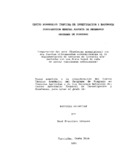| dc.contributor.advisor | Romero, Francisco | es_Es |
| dc.contributor.author | Vásquez, R.F. | |
| dc.contributor.other | CATIE - Centro Agronómico Tropical de Investigación y Enseñanza | |
| dc.coverage.spatial | Turrialba, Costa Rica | |
| dc.date.accessioned | 2014-10-17T06:41:33Z | |
| dc.date.available | 2014-10-17T06:41:33Z | |
| dc.date.issued | 1991 | es_ES |
| dc.identifier | 339363 | es_ES |
| dc.identifier.uri | https://repositorio.catie.ac.cr/handle/11554/830 | |
| dc.description | Tesis (Mag. Sc.) -- CATIE, Turrialba (Costa Rica), 1991 | es_ES |
| dc.description.abstract | Se evaluó el follaje del poró (Erythrina poeppigiana) comparado con dos fuentes nitrogenadas: harina de pescado y urea como suplemento en novillas de lechería alimentadas con una dieta basal de caña de azúcar integral y con una suplementación energética de melaza y pulidura de arroz. Se utilizaron 24 novillas de las razas Jersey, Criollas y sus cruces, con un peso promedio de 150 kg. Además, se utilizaron 3 novillos fistulados con un peso promedio de 400 kg. Las novillas estuvieron estabuladas. Los resultados evidenciaron que los parámetros de fermentación ruminal: pH, concentración de ácidos grasos volátiles y las proporciones molares, ácido acético, ácido propiónico y ácido butírico no fueron modificados por el efecto de degradación ruminal de las diferentes fuentes nitrogenadas. Sin embargo, la concentración de nitrógeno amoniacal en el rumen y urea-nitrógeno en sangre fueron ligeramente modificados. A su vez el tratamiento de follaje de poró tuvo igual consumo de ED que el tratamiento de harina de pescado (7,16 Mcal kg PV/d). El tratamiento de harina de pescado produjo ganancias diarias promedios de 0,763 kg/novilla/día, superior (P<0,05) a las obtenidas con urea (0.592 kg/novilla) pero similar al tratamiento de poró (0.647 kg/novilla/día). La eficiencia biológica de utilización de la proteína y la ED consumida fue mayor en el tratamiento con harina de pescado. Sin embargo, el análisis económico indicó que en la suplementación con follaje de poró y urea, los costos variables son menores con respecto a la harina de pescado. | es_ES |
| dc.description.abstract | Poro (Erythrina poenpigiana) folliage was compared to two sources of nitrogen: fish meal and urea as a supplement for dairy heifers fed a base diet of integral sugar cane and an energy supplement of molasses and rice polishing. Twenty-four Jersey, criollo and cross-breed heifers with an average weight of 150 kg were used. Three young fistulated bulls (400 kg B.W) were also used to study the ruminal dynamics and fermentation patterns. The heifers were confined and were offered an individual daily ration which was calculated to fill the nutritional requirements for a daily weight gain of 800 g. They were given water twice a day, and had continuos access to mineral salts. A completely random design balanced with eight replications was used to evaluate weight gain; a 3x3 Latin square was used for the fistulated bulls, and an arrangement of split plots was used for both designs. Results indicated that ruminal fermentation, PH, volatile fatty acid, and molar proportion concentrations, acetic acid, propionic acid and butyric acid parameters were not changed by the effect of ruminal degradation of the different nitrogen sources. There were significant differences (P<0.05) between the sources evaluated for the diet rate of passage; the rate of the poro folliage superior to the other nitrogen sources. As far as nutrient utilization efficiency is concerned, the fish meal treatment requires less protein and energy to produce a kilogram of meat than the other nitrogenated sources. | |
| dc.format.extent | 121 páginas | |
| dc.language.iso | es | es_ES |
| dc.publisher | CATIE - Centro Agronómico Tropical de Investigación y Enseñanza | es_ES |
| dc.subject | PRODUCCION DE BIOMASA | |
| dc.subject | PORO | |
| dc.subject | NITROGENO AMONIACAL | |
| dc.subject | COSTA RICA | |
| dc.subject | CALVES | |
| dc.subject | DIGESTIBLE NITROGEN | |
| dc.subject | SUPPLEMENTS | |
| dc.subject | ANIMAL FEEDING | |
| dc.subject | NUTRITIVE VALUEERYTHRINA POEPPIGIANA | |
| dc.subject | SACCHARUM OFFICINARUM | |
| dc.subject | VALOR NUTRITIVO | |
| dc.subject | TERNERO | |
| dc.subject | NITROGENO | |
| dc.subject | ASIMILABLE | |
| dc.subject | SUPLEMENTOS | |
| dc.subject | ALIMENTACION DE LOS ANIMALES | |
| dc.title | Comparación del poró (Erythrina poeppigiana) con dos fuentes nitrogenadas convencionales en la suplementación de terneras de lechería alimentadas con una dieta basal de caña de azúcar (Saccharum officinarum) | es_ES |
| dc.type | Tesis | es_ES |
| dc.identifier.publication | Turrialba (Costa Rica) | es_ES |
| dc.status | info:eu-repo/semantics/openAccess | |


